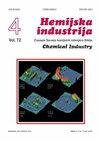饮用水澄清工艺装置的稳健性分析:正常和紧急运行条件
IF 0.8
4区 工程技术
Q4 ENGINEERING, CHEMICAL
引用次数: 0
摘要
供水系统的主要目标是通过提供微生物和化学安全的饮用水来保护人类健康。水质的重大变化需要足够强大的水制备系统,其性能不受当前变化和不断变化的操作条件的影响。水浊度是影响水过滤控制和消毒效率的重要参数。饮用水处理厂的除浊效率?本文对Banjaluka在正常和紧急工况下的运行情况进行了研究。在正常条件下,最大检测值为25 NTU,而在紧急运行条件下,它超过240 NTU。对水澄清系统的稳健性评估分别在正常和紧急操作条件期间(排空堆积期间和之后)进行。鲁棒性指数是根据比现行立法规定的更严格的目标浊度值(0.5 NTU)计算的,这代表了现有实践中风险分析的新标准。数据处理结果表明,工艺装置在正常工况下具有较高的运行稳定性。在所有循环中,过滤后的水质在大部分时间内都低于目标值。记录的浊度值为?92.9%的过滤水样为0.3 NTU。对水浊度数据的分析表明,在紧急运行条件下进行的所有测量中,有17%(336个样本)的浊度高于目标值(0.5 NTU)。在紧急运行条件下,在短时间内原水浑浊度变化很大,给饮用水厂的快速反应带来了问题。计算出的稳健性指数值表明,在一定数量的过滤器运行循环中,水澄清过程的效率不足。我们发现,在紧急情况下,工厂运行条件对过滤水浊度有重大影响,例如不理想的混凝和絮凝条件,以及引起浊度的悬浮和胶体颗粒的性质,以及颗粒与混凝剂的相互作用不足。混凝剂投加量过大不仅会对水的浊度产生负面影响,还会导致过滤水中残铝浓度升高。在充分监测水源的基础上,优化应急工况,进一步降低饮用水中出现病原体的潜在风险。本文章由计算机程序翻译,如有差异,请以英文原文为准。
Robustness analysis of technological units for drinking water clarification: Normal and emergency operating conditions
The primary goal of a water supply system is the protection of human health by providing microbiologically and chemically safe drinking water. Significant changes in water quality require sufficiently robust systems for water preparation, performances of which are unaffected by present variations and changing operational conditions. Water turbidity is an important parameter for the water filtration control and efficiency of disinfection. The efficiency of turbidity removal in the drinking water treatment plant ?Vodovod? in Banjaluka under normal and emergency operating conditions was examined in this paper. At normal conditions the maximal detected value was 25 NTU while at emergency operating conditions it was above 240 NTU. Robustness evaluation of the water clarification system was performed separately for periods of normal and emergency operating conditions (during and after emptying the accumulation). The robustness index was calculated based on a more stringent target turbidity value (0.5 NTU) than that specified by the current legislation, which represents a new criterion in the risk analysis in the existing practice. Data processing results indicate high operational stability of technological units under normal conditions. The filtered water quality was below the target value during most of the time of filter operation in all cycles. The recorded turbidity value was ? 0.3 NTU for 92.9 % of filtered water samples. Analysis of the water turbidity data has shown that 17% of all taken measurements under emergency operating conditions (336 samples) had higher turbidity than the target value (0.5 NTU). Large variations in raw water turbidity over short periods of times during the emergency operating conditions, present a problem for prompt response in the drinking water plant. Calculated robustness index values point to inadequate efficiency of the water clarification process in a certain number of filter operating cycles. We have found a significant impact of the plant operating conditions on the filtered water turbidity under emergency conditions, such as suboptimal coagulation and flocculation conditions as well as the nature of suspended and colloid particles inducing turbidity and insufficient particle interactions with the coagulant. Along with the negative influence on water turbidity, excessive coagulant dosage leads to increased concentrations of residual aluminum in filtered water. Optimization of emergency working conditions could be performed based on adequate monitoring of water sources, which would further decrease potential risks of pathogen appearance in drinking water.
求助全文
通过发布文献求助,成功后即可免费获取论文全文。
去求助
来源期刊

Hemijska Industrija
工程技术-工程:化工
CiteScore
1.60
自引率
11.10%
发文量
12
审稿时长
6-12 weeks
期刊介绍:
The Journal Hemijska industrija (abbreviation Hem. Ind.) is publishing papers in the field of Chemical Engineering (Transport phenomena; Process Modeling, Simulation and Optimization; Thermodynamics; Separation Processes; Reactor Engineering; Electrochemical Engineering; Petrochemical Engineering), Biochemical Engineering (Bioreactors; Protein Engineering; Kinetics of Bioprocesses), Engineering of Materials (Polymers; Metal materials; Non-metal materials; Biomaterials), Environmental Engineeringand Applied Chemistry. The journal is published bimonthly by the Association of Chemical Engineers of Serbia (a member of EFCE - European Federation of Chemical Engineering). In addition to professional articles of importance to industry, scientific research papers are published, not only from our country but from all over the world. It also contains topics such as business news, science and technology news, information on new apparatus and equipment, and articles on environmental protection.
 求助内容:
求助内容: 应助结果提醒方式:
应助结果提醒方式:


